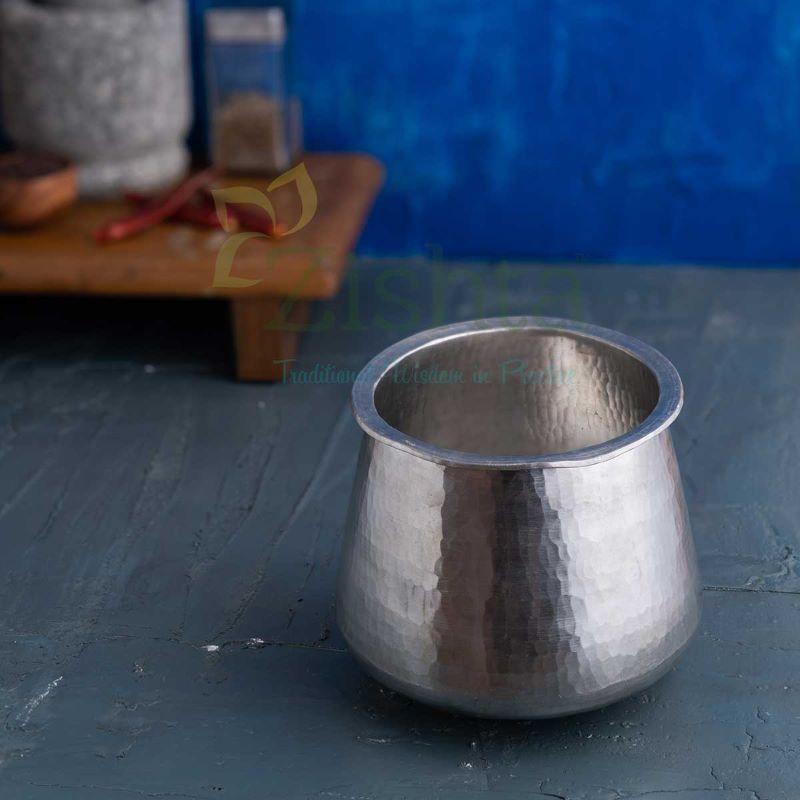The worlds tastiest rasam is always made in tin vessel. The use of tin vessels in South India is a part of the region's rich culinary and cultural traditions. Tin vessels have been commonly used for cooking and serving food for generations, especially Rasam. Here are some of the traditions and reasons behind the use of tin vessels in South India:
- Conductive Properties: Tin is an excellent conductor of heat, which makes it ideal for cooking. It distributes heat evenly, allowing for precise control over the cooking process, especially for dishes that require slow and steady simmering. This property makes tin vessels popular for traditional South Indian cooking methods.
- Preservation of Flavour: Tin vessels are believed to enhance the flavours of the dishes. The tin reacts with the acids present in ingredients like tamarind or tomatoes, which can help develop a unique taste. This is especially valued in South Indian cuisine.
- Aesthetic Appeal: Tin vessels often have an aesthetic charm. South Indian households and restaurants use tin utensils for serving food, especially for traditional meals served on banana leaves or in traditional settings.
- Rituals and Festivals: Tin vessels are also a part of religious rituals and festivals in South India. They are used to cooking and serving special dishes during festivals and ceremonies.
- Cultural Significance: Tin vessels have cultural significance and have been passed down through generations in many South Indian families. Using these vessels is a way to connect with and honour one's cultural heritage.
What different purpose Tin vessel can be used:
Tin vessels have always been used for making the tastiest rasam. The cluster of artisans who make them have used tin vessel for the following purposes:
- Make the tastiest Rasam.
- Set curd in the tin vessel.
- Store cooked food overnight to prevent it from spoiling.
- Serving cooked food.
- Making soup and simple lentil watery dals as well.
- Boiling Milk.
How tin Vessels are made:
Tin vessels are made of pure tin and it takes hours to make each vessel. The process starts with melting tin ingots and pours out to a thick sheet and in a circular shape. Once that is done, the tin sheet is beaten using a small wooden hammer to the shape the vessel is to be made. The final work of beating the sheet to different shapes takes hours of work in a wooden mould where the beaten tin vessel is placed to bring the vessel to shape. This process takes six - seven hours to make each vessel.
Misconception between Tin and Lead
Tin is a metal by itself and it’s not an alloy. Lead is a different metal and in Tamil eeyam is a common word for both tin and lead. Velleyam is tin and kaareeyam is lead. Now this has resulted in the confusion that these amazing vessels are made to lead when in fact they are made of pure tin.
Benefits of cooking Rasam in tin vessel
Tin in Ayurveda is known for its amazing properties for long term diabetes management, UTI management and balancing phlegm in your body. Comprehensive research on Rasam was published in the National Library of Medicine (https://www.ncbi.nlm.nih.gov/pmc/articles/PMC5628526/) shares all the critical benefits of having Rasam and the same is further enhanced by cooking in Tin vessel.
- Managing hypoglycemia.
- Treatment for Anemia.
- Improves Lactation among new mothers.
- Anti-Microbial, Laxative, and general health improvement.
- Tin vessels have a very low melting point of just 231.9 degrees Celsius. Please do not keep them empty on gas, otherwise it will melt within seconds of leaving them in gas.
- Always make sure you fill the vessel up to a third of its height with water or tamarind water and then place them in gas burner.
- Use cloth to lift them when it’s hot - do not use tongs as they are extremely malleable metal and will bend when it’s hot.
- Tin is a very good conductor of heat. Use the vessel in medium or low flame.
- You can wash them using regular soap and clean. Please handle them with care as they can deform easily under pressure.
- The inside cooking surface tends to turn black with usage and its the natural property of tin metal. Occasionally scrubbing the inner surface with washing soda and lime/tamarind mixture helps to remove the blackness on the surface and bring back the shine.
Read FAQ's on Tin Vessel in our blog Eeya Chombu FAQs!




2 comments
Renuka
I want EEya sombu
Smita S
Thank you for info and efforts….
Keep it up
Leave a comment
All comments are moderated before being published.
This site is protected by hCaptcha and the hCaptcha Privacy Policy and Terms of Service apply.